The Trek to North Pole
Many expeditions choose the Russian route although it's longer than the Canada route,because it's smoother and has a positive drift. In Canada, the ice is pressed towards the land, in Russia it floats away from the land. That means ice rubble in Canada, and open leads in Russia.
If you choose to go from Russia, be prepared for more Polar bears and more open water, at least initially. If you choose the “classic route” – Canada – you can expect hard going and counter drift. Although the Russian route has been considered “easier” by tradition, serious open water have affected the end results seriously in the recent years.
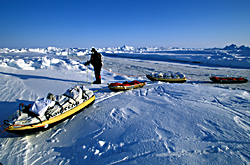
The classic route (Canada)
You will leave Resolute Bay in the early hours. A “go” call from the pilots will wake you up around 4 AM and you'll have your last bacon and egg breakfast in the warmth of the hotel. It will be dark and cold outside, and you won't feel much like talking.
A few hours later the small plane stops over in Eureka, the last human settlement up north. It's a research station and not much else. A barren, frozen tundra by an ocean inlet, a few icebergs frozen stuck in the ice flow.
Half an hour or so later you are back up in the air, watching America's Northernmost mountains disappear below you. You feel an increasing terror. There is nothing but hostile land mile after mile, not meant for humans at all, but where you are going it's even worse. And soon you spot it. The ocean. A jagged maze of open leads and pans of ice forming a intricate pattern like bindings out of some chemistry class. It looks, and is, very inhospitable. Your only neighbor in this top frozen ocean will be the blood red, cold sun and the occasional man eating polar bear. The plane lands just off the coast, in other climate conditions this would probably be a beach. And before you even have the chance to finish the “hey-wait-a-minute” sentence the pilots are gone. And the warm, cozy plane along with them.
Camp routine
Don't camp up. Hook on to you sled and go immediately. After around 2-3 km of a weak incline, you reach the shoreline. The instep is a sharp wall and your first obstacle. This is the place to make the first camp. There is often an open lead just between the shore and the ocean and it freezes over night. Make your camp in the last light of the declining sun.
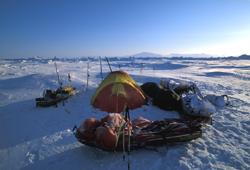
Now commence the challenge of your unsupported trek. If you allow your sleeping bag and clothes into the tent when you cook, they will ice up within weeks. A sleeping bag can easily add on 20 kgs, 40 lbs of ice. So you don't. Put up your tent. Take the shovel, cover the tent on all sides with snow and fill the vestibule with some fresh snow for water, then strip out of your outer shell clothing. It will be covered with ice on the inside (your frozen sweat). Brush it off with a hard brush. Throw in sleeping pads, food bag, kitchen stuff and other gear in the tent but leave the sleeping bags and gun outside. Arrange the sleeping pads over each other. Cover the floor with three diagonal Ridge Rests, and then add another two fitting them crosswise on top. One lightweight foam mattress is very handy for all kinds of things, not just to sleep on.
In this cold, everything has to be organized. The stove, fuel, warming cup - all in one place. The lighter should be pre-warmed in the palm of your hand inside the glove as you work outside (always carry the lighters in your inner pockets on travel). Needless to say, you must work fast. Once you put on the stove, you are wearing only your underwear and sit on the bare ridge rest. Don't light up the stove until just ready to cook, you can't afford to waste gas. At Antarctica you cook in the vestibule, in the Arctic you cook inside the tent, and without heat exchangers due to the severe cold. Make sure to ventilate well at night.
Place the stove on top of a plywood board. In extreme cold, pour a teaspoon of gas in a metallic cup. Set on fire. A tall flame will brush the inside wall of the tent. Have a lid at hand to protect the tent roof from the fire. Heat the stripped stove nozzle in the flame. As the flame dies out, turn on the stove and light up. This procedure must be practiced before hand! As soon as the stove is on, put on the first pot with snow. Always have a small amount of water in the bottom before filling up with snow (save up from today's drinking water). It will melt the snow easier and faster. Cover with the lid.

Now is your only time in warm temperatures. This is the time to make repairs, work technology and prepare for tomorrow. Develop an organized, efficient schedule. Never leave water to boil or the fire on without cooking or melting snow. You'll run out of fuel if you do. Place all water bottles, thermoses and food in an exact order by the kitchen so you can work fast with each boil. Organize the procedure so you can eat in the warmth of the fire melting tomorrow's water. In extreme cold, it's a good idea to work two stoves at once; it will heat the tent better, and cut your cooking time by half. If you do work two stoves though, you must be even faster with regards to camp routine. You should work so fast that you even break a sweat.
Warm the technology and batteries hanging them in the ziplock bags on the dryline. Remove socks, hats, gloves and such and hang on dryline so the stuff can dry while you cook. It's a good idea to attach several drylines in the roof of the tent, diagonal to the straight one. Hold stuff in place with clothes- or oversized safety pins to prevent from falling down on the burner flame below. Take the clothes down again before sleep and keep them inside the sleeping bag. Leave your boots in the vestibule, they will keep better if never thawed. If you are prone to frostbite however, bring them in. Do your tech work, but leave calls and reading of e-mails until later (the sleeping bag).
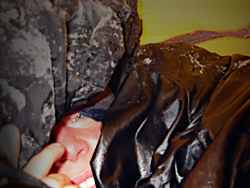
When you've finished your meal and all bottles are filled up, turn off the stove. Don't bring in the sleeping bag until the temperature in the tent is below zero! You need to get rid of all the moisture and heat. This is a cold and dreadful wait, but hey it's what you came for, stupid!..:)
Around ten minutes later, jump out and bring in the sleeping bag. The sleeping bag should be an elaborate system of a vapor barrier, sleeping bag, another vapor barrier, a fleece cover and an outer layer. After a few weeks of travel, it will be frozen solid and not very easy to squeeze into. Throw in a hot water bottle to make your entrance at least a little more pleasant. Soon enough your body will start to warm the bag (if you strip entirely) and you enter the best time of the day. Warm and still at last! Read your mails and make a few replies. Call mum. For a while you'll listen for polar bear steps, but soon enough your poor and battered being will be sound at sleep. Have a good first polar night!
On travel
The terror continues first thing in the morning. Brush of the snow from the inside walls with a hard brush and turn the sleeping pad over to collect all snow below it. Get out of the sleeping bag and throw it out. Don't forget to empty out the tech, clothes, bear spray and water bottles first. Always buy an extra long sleeping bag as it will hold lots of stuff in addition to you.
Put on the stove for the morning melt. The stove shouldn't burn more than 10-20 minutes in the morning. Dress quickly and prepare for today's travel. Always carry navigation gear, snacks and other stuff in assigned pockets so you don't have to search for it with cold hands on travel. Expect not to be able to stand still for more than a few minutes from now on, at least in the early cold temperatures. You must work extremely fast or frostbite will crawl up on you in minutes.
Carry the water bottle on you, or it will freeze. Carry more water in thermoses on the sled. Calibrate your compass and check the night's drift. Get out of the tent, pack up the sled and climb a pinnacle to scout a route if you didn't the evening before (it's a good thing to scout next day's route before camp in case of bad weather in the morning). If you are near sighted, your lenses will freeze and shatter to pieces in your eyes. Use prescription sunglasses.
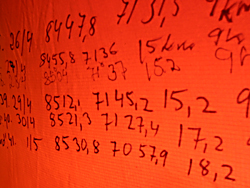
Look for flat areas but don't deviate too much from the direction. Don't force ice rubble if not necessary, but stay on target. Find ways around obstacles, not on top of them. Clever navigation will save your strength and gear. Due to the easterly drift, always go left when in doubt.
Watch out at high pinnacles, the sled will come rushing down behind you. Step aside and let it go, your feet planted firm in the snow to brake the rush. Avoid blue rubble at all costs. At high or wide ridges, remove your skis and poles and throw them over to the other side. Climb up pushing your sled behind. Let it go on the other side, holding on to it to brake the fall. Climb back down behind it, put your skis back on. Learn to do this without bending over, securing the bindings with the tip of the ski pole. Attach your sled back to the harness, have a piece of chocolate and leave for the next ridge.
Most often, there will be ridge-pan-ridge areas. Don't spend too much time contemplating each ridge. Just find the flattest section and take it on immediately. Sometimes there are vast areas of blue rubble. Blue rubble is simply entire pans broken up into an inferno of overturned ice chunks. The blue is the water side of the pan. It's sharp and slippery. If you can't find a reasonable way around it however, you'll have to get into it. The area might last a few hours or even a few days – but it will always end.
When looking for a campsite, search for areas of old rubble – smooth and grayish white ice sastrugi. Those areas are the thickest parts of the ice and the safest for lay up. If the pan begins to break up, it will least likely break through this old, thick ice (although it's not a guarantee). Camp on top of one of those small hills if possible. Always camp away from a lead and preferably on the northern shore of it (going from Canada). If it's difficult to run the tent pegs into the ice (most often though there is enough snow) tie your sled up to the pulk. Don't melt blue ice for water, it's salty. Collect snow from old ice. If you drink brackish water often enough, you'll soon end up so thirsty you'll lick the frost from the tent walls at night!
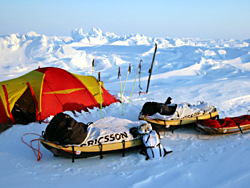
Get out every single day. Plan for a rest day only once in ten days at the most. A team not moving is a first sure sign of trouble and probable failure. There will be fog. Go out in it. There will be wind. Get out there. There will be fog, wind and repairs to your gear badly needed. No excuses. Stay inside the tent ONLY in a bad storm. If you are lucky, the storm will hit you on your rest day. That's why it's good to push even beyond rest days, that way you won't suffer too much delay when a storm hits. You shouldn't spend more than 3-5 days in the tent throughout the entire expedition.
In the beginning of the trip, the sun will set and you'll be enveloped in Arctic nights. Soon enough the sun will just sit on the horizon for a while; a striking cold, deep red lantern. Within weeks however, it will circle endlessly above, and you will enjoy clear, but bitterly cold weather. Already four weeks into the trek the ice will begin to melt considerably and fog will rise from the ocean embedding you in clouds. “Water clouds” vertical smoky black pillars in the sky will mirror huge open water leads. Use them for navigation to stay away from open water areas.
The temperatures will climb and though the travel is easier, with a smoother surface and more tolerable cold, this is the time to start swimming open leads and skiing thin ice. Try the ice by poking it with the ski pole. Three strong hits are fine, two is questionable, and one is too weak for travel. When crossing thin ice, it is essential to move fast. Check “navigation” and “dangers” for instructions on how to swim and paddle leads. Around mid April, you can drop the sleeping bag fleece cover, the synthetic down jacket and other extreme cold weather gear. This is the time to drop the smaller of the two sleds.
As you approach the 87.00 degree the drift will increase, sometimes even earlier at 86.00. Don't try to make up for it too much, just keep to target. Don't panic even if closing in on the dangerous 60.00 longitude. The drift changes back and forth. Trying to make up for it will only make you loose time. Expect more open water leads and ice movement in general.

Towards the 88.00 degree, you'll travel in an almost endless fog, day after day. It will be so warm that your tent will be dripping inside. You can now easily get rid of the vapor barrier of the sleeping bag and cut down the skins for faster travel (20 cm front and 20 cm back, try a piece at a time). The good news also is that fuel lasts much longer and you'll be able to work in camp without the heat of the stove. Everything will revive; the technology, the batteries, gear and all kinds of stuff. Everything will soften up and life becomes more pleasant in general. Unfortunately, the fog obscures the sun so you still can't expect the nice, sunny camps of Antarctica.
The terror of the last degree is vast areas of open water, impossibly soft ice, treacherous conditions and diminishing resources – namely fuel. In addition, the last date for flight out looms. This is where your success or failure will be determined by your earlier decision. If you spent too many days in camp, or if you came out too late on the ice, you will simply run out of time and food. Your fuel will come to an end if you weren't fast enough in camp and you might have to opt for a re-supply, throwing over all that work you have put into going unsupported. The plane will refuse to pick you up after a certain date, and you'll have to stop only weeks short of your dream. There are too many unfinished grand projects out there in the world – don't become one of them. The difference lies interestingly not in the end battle, but in the discipline of each and every day.
But even if you did what you had to do, the end will be a fight against time. There is not much left to do but run for your life. You will ski around the clock, up to twenty hour pushes. This is the end battle – the war against the drift. Holding your breath, you'll attack the ridges, the leads and the ice in sheer desperation. For every two steps that you force forward, the ice pushes you back one.
You camp and wake up far behind where you lay your hat yesterday. It will be enough not to give you any rest. If a huge lead emerges, or a serious area of rubble, you'll have to spend so much time in it that you'll make no progress at all – whilst your last supplies run out. This is the time to just go and not think.
Yet this is also the time to take great care. You are so tired that you see false visions, you hear voices and your legs tremble with each move. You are actually losing it in the world's most dangerous place. You can't judge the ice as you used to – the shores look firm but are soft as whipped cream. The ice looks solid but breaks at your first poke. The entire ground you ski is melting away, leaving treacherous traps of thin ice and loose snow everywhere. This is the North Pole in the end of May.
A few days away from the pole, start to look for landing strips. Make mental notes of good, flat pans. That will make your pick up much easier. The plane can start to fly in as you near the pole, and you'll be able to meet it in a good spot.
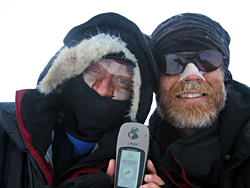
Soon enough though, you'll pick that GPS out from your pocket and watch the digits in awe: 98.97….you'll take a few more steps forward…….98.98….keep going….98.99…your hand tremble….99.00.00!
You made it, mate. Welcome to the top of the world!